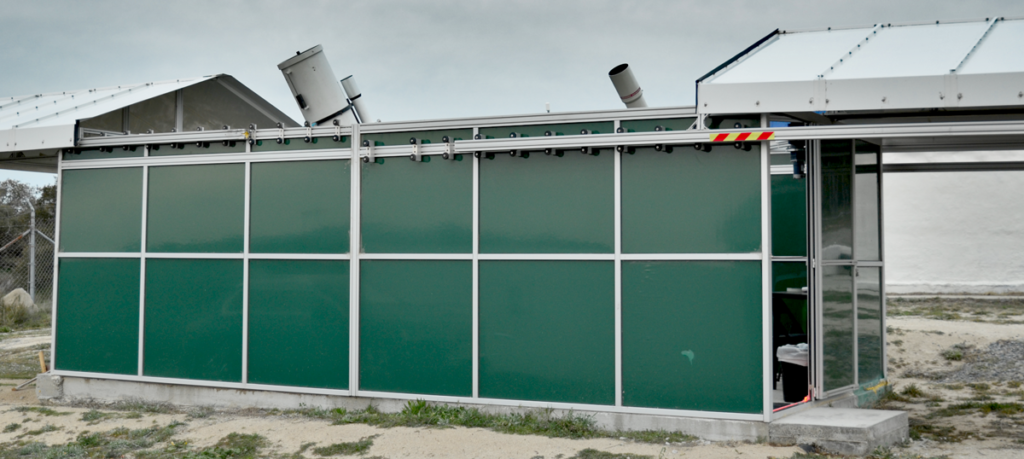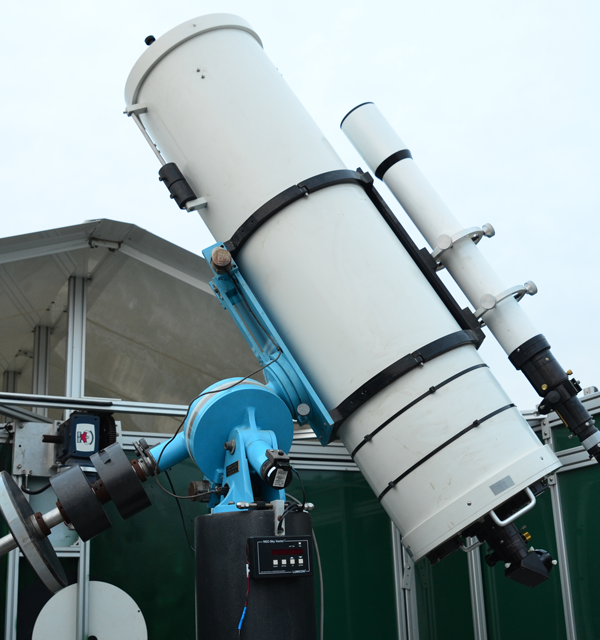
A unique benefit available to SDAA Full Contributing members is access to a premier visual observing facility located at our Tierra Del Sol Dark-Sky Observing Site. Cruzen Observatory may be reserved and utilized by SDAA members with at least one year of tenure and after completing a simple training session. Eligible members should think of Cruzen like the SDAA Loaner Scopes program, only instead of loaning a telescope, members can loan out an entire observatory for an evening!
The observatory is comfortably appointed, with an easy-to-use electric rolling roof system and permanently-mounted telescopes. The facility is equipped with chairs, tables, step ladders, and dimmable red lighting for comfort and convenience. Both permanently mounted telescopes are available for members’ exclusive use, along with a full complement of premium Televue, Pentax, and Vixen eyepieces. Members may use their own eyepieces if they like. A comprehensive printed operations manual is provided as well.
Takahashi TOA-130
The Takahashi TOA-130 is a 130mm (5.3″) aperture f/7.7 triplet apochromatic fluorite refractor of 1000mm focal length. It is excellent for visual observations of the moon, planets and large deep sky objects such as galaxies and nebulae. The high order of color correction of the Ortho-Apochromat Series produces images with saturated color and, thanks to the numerous knife-edged baffles, it also displays an image with amazing contrast.
The TOA-130 is mounted on a Losmandy G-11 mount with a Gemini II go-to controller. The Losmandy G-11 may be used manually, or with the hand box, or using a provided laptop running Stellarium and ASCOM mount control software.
Large objects like the California Nebula, the Orion Nebula, and the Andromeda Galaxy look absolutely amazing in this instrument, which can deliver a nearly 3 degree field of view with perfect pin-point stars from edge to edge. And bright, small objects like double stars and planetary nebulae look amazing due to the high order of color correction and lack of a central obstruction.


14.5″ f/18 Dall-Kirkham
The Dall-Kirkham Cassegrain (DK) is 14.5″ aperture with a focal length of 6630mm and f/18. The Dall-Kirkham optical design features an elliptical primary and a spherical secondary. This design reduces field curvature compared to a classical cassegrain, but does not correct for off-axis coma. The optics in Cruzen’s DK were figured by R. F. Royce. It is particularly suited for objects where high magnification is desired, such as planets, multiple stars, globular clusters, planetary nebulae, and many galaxies.
The mount is a vintage Shaefer German Equatorial with a stepper motor clock drive on the RA axis. You position the telescope by hand in the desired axis. There are no locks that need to be loosened or tightened.
Location of deep-sky objects is easy with the combination of Lumicon SkyVector Digital Setting Circles, a Stellarvue refractor serving as a finderscope, as well as a trusty Telrad.
The long focal length, slow optical configuration, and small secondary obstruction result in amazingly sharp and contrasty views at very high magnification. Have you ever spied the Encke Gap in Saturn’s rings? Resolved individual stars in the core of M13? With this scope, you will!
Reservations and Training
Before SDAA members can reserve and utilize Cruzen Observatory, they must be a Full Contributing Member for at least one year, and must have completed Cruzen training within the last three years.
Training sessions are offered semi-annually. Members should contact the Cruzen Director to get assigned to a training session. Training takes place at the Tierra Del Sol Dark-Sky Observing Site, and takes about an hour. A comprehensive operations manual is provided with the observatory to supplement the training.
Once trained, Cruzen-eligible members will be granted access to an online signup sheet allowing them to reserve nights at the observatory.
Rules of Use
This is an abbreviated list; the comprehensive list of rules can be found in the Cruzen Operations Manual.
- Only SDAA Full Contributing Members, who have completed Cruzen training, may use and operate the observatory. Authorized members are tracked with the “Cruzen Observatory” group in Wild Apricot.
- Nights at Cruzen must be reserved at least 48 hours in advance; there are no “walk-in” or last-minute reservations. Reservations are made via an online booking system.
- SDAA members use Cruzen at their own risk. Be careful when moving around to avoid counterweight shafts and tripping hazards.
- SDAA members may bring no more than three guests into Cruzen. Children must be controlled and may only look through the telescopes if they are old enough to understand how to view through the eyepiece without grabbing it with their hands.
- Cruzen observatory is not to exceed four people within the building at any time.
- Check wind speed throughout the night: If it is too windy to comfortably use a Dob, it is too windy to open Cruzen.
- Do not touch or attempt to clean any optical surfaces on either the telescopes or the eyepieces.
- Do not attach cameras of any kind to telescopes, including cell phones. Absolutely no exceptions.
- Please keep the back (north) door closed/locked.
- Immediately clean up any spills, crumbs, etc.
- Cruzen is a “leave no trace” facility. Pack out everything you bring in, including trash.
- Promptly report any maintenance issues to the Cruzen director: cruzen@sdaa.org.
Frequently Asked Questions
May Cruzen be used for public outreach? What about visitors on public star party nights?
The Cruzen observatory is for SDAA Full Contributing members only. The Lipp observatory is the club’s primary “outreach” telescope. The Cruzen is not equipped or staffed for public outreach and must not be used for that purpose.
Can I use the Cruzen telescopes for astrophotography?
No, the Cruzen observatory is strictly for visual use. No cameras may be attached to either telescope. No exceptions. If you are interested in astrophotography but do not have your own imaging rig, you may be interested to know that the SDAA Loaner Scopes program has astrophotography rigs available!
What do I do if something goes wrong?
If you are having trouble locating objects or using the mounts, take a deep breath and review the provided operations manual carefully. There is of course always the chance of an equipment or configuration failure, but it’s most likely that you’re just missing an important step during the setup process. Slow down and try again. If you need an extra set of eyes, see the contact information in the operations manual. Please note that “I can’t work the Lumicon DSC” or “I can’t work the Gemini-2” or “I can’t find <object> in the eyepiece” are not emergencies worth waking up the Cruzen or Observatory Directors.
